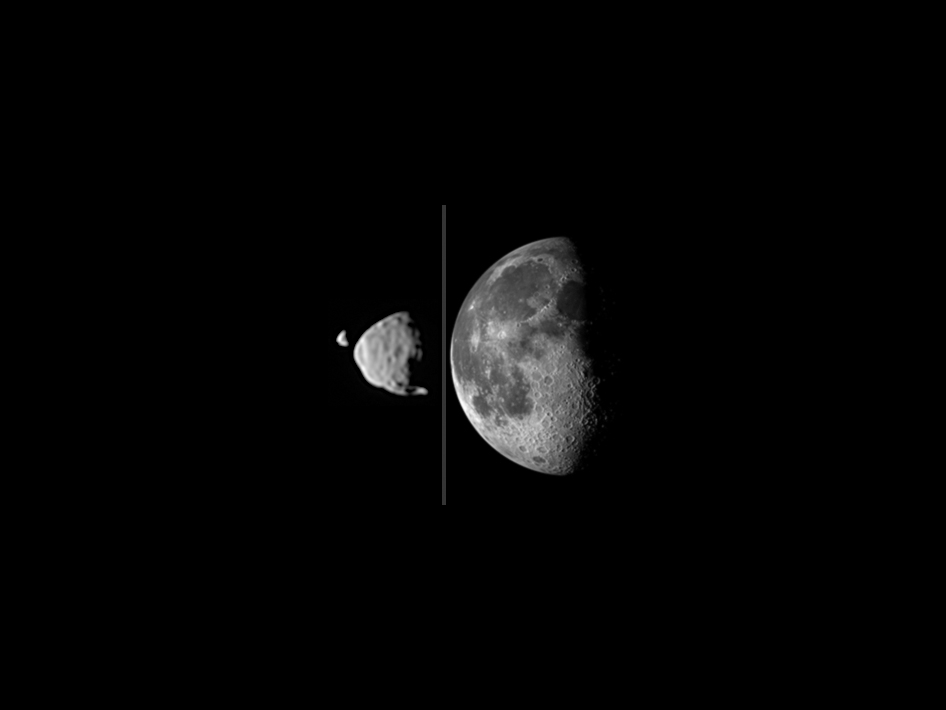
PASADENA, Calif — The larger of the two moons of Mars, Phobos, passes directly in front of the other, Deimos, in a new series of sky-watching images from NASA’s Mars rover Curiosity.
Large craters on Phobos are clearly visible in these images from the surface of Mars. No previous images from missions on the surface caught one moon eclipsing the other.
The telephoto-lens camera of Curiosity’s two-camera Mast Camera (Mastcam) instrument recorded the images on Aug. 1. Some of the full-resolution frames were not downlinked until more than a week later, in the data-transmission queue behind higher-priority images being used for planning the rover’s drives.
[youtube_video]http://youtu.be/DaVSCmuOJwI[/youtube_video]
Video courtesy of NASA/JPL/MSSS
These observations of Phobos and Deimos help researchers make knowledge of the moons’ orbits even more precise.
“The ultimate goal is to improve orbit knowledge enough that we can improve the measurement of the tides Phobos raises on the Martian solid surface, giving knowledge of the Martian interior,” said Mark Lemmon of Texas A&M University, College Station. He is a co-investigator for use of Curiosity’s Mastcam. “We may also get data good enough to detect density variations within Phobos and to determine if Deimos’ orbit is systematically changing.”
The orbit of Phobos is very slowly getting closer to Mars. The orbit of Deimos may be slowly getting farther from the planet.
Lemmon and colleagues determined that the two moons would be visible crossing paths at a time shortly after Curiosity would be awake for transmitting data to NASA’s Mars Reconnaissance Orbiter for relay to Earth. That made the moon observations feasible with minimal impact on the rover’s energy budget.
Although Phobos has a diameter less than one percent the diameter of Earth’s moon, Phobos also orbits much closer to Mars than our moon’s distance from Earth. As seen from the surface of Mars, Phobos looks about half as wide as what Earth’s moon looks like to viewers on Earth.
NASA’s Mars Science Laboratory project is using Curiosity and the rover’s 10 science instruments to investigate the environmental history within Gale Crater, a location where the project has found that conditions were long ago favorable for microbial life.
Malin Space Science Systems, San Diego, built and operates Curiosity’s Mastcam. JPL, a division of the California Institute of Technology in Pasadena, manages the project for NASA’s Science Mission Directorate in Washington and built the Navigation Camera and the rover.
More information about the mission is online at: http://www.nasa.gov/msl and http://mars.jpl.nasa.gov/msl/
You can follow the mission on Facebook and Twitter at: http://www.facebook.com/marscuriosity andhttp://www.twitter.com/marscuriosity
For more information about the Multi-Mission Image Processing Laboratory, see: http://www-mipl.jpl.nasa.gov/mipex.html
Guy Webster 818-354-6278
Jet Propulsion Laboratory, Pasadena, Calif.
guy.webster@jpl.nasa.gov




Incredible video! Can Curiosity spot Earth as well when in proper alignment?
I beleive Tom, that Curiosity could photograph Earth, when in the proper position. Earth has already been photographed by one of the MER rovers, a couple of years ago.
It’s pictures like these that really bring home the excitement and sheer awesomeness of space exploration! When will these sights finally be witnessed by human eyes there?
Eventually we will journey beyond the Moon and explore Mars. A monumental undertaking but one which will bring out the very best in humanity’s quest to find the “answers” to the age-old question “Are we alone?” (No, we are not!)
That would be the most monumental time of all! It would slice history in two halves, just as the Moon landings have done!
That said, there is the strong possibility that any possible Mars life may have the same origins as Earth’s, through the distribution of organic material from meteorite exchanges between the two planets. If that was proven to be the case, would any Mars life be characterised as ‘alien’? If life on Earth and Mars arose concurrently through the same ingredients elivered from meterorites, would we need to go further out in the Solar System to find ‘alien’ life?